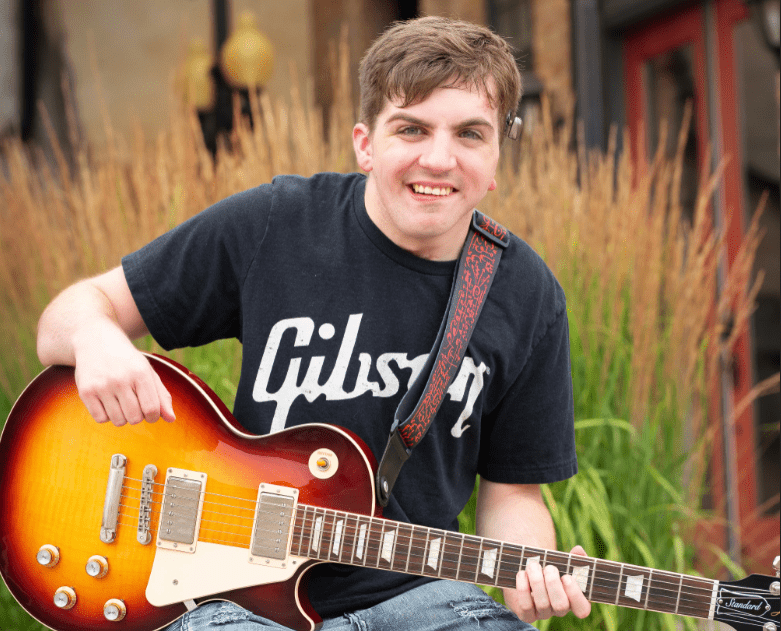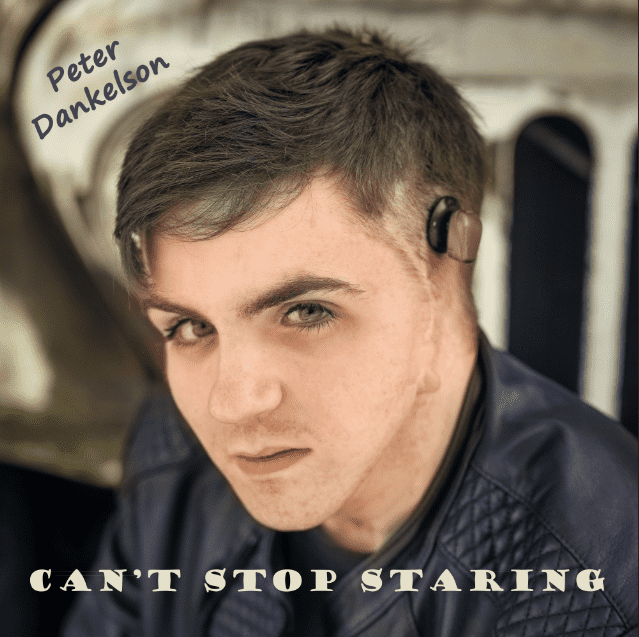Since birth, Peter has been no stranger to hardships, being a child with Goldenhar syndrome, microtia and atresia and numerous other birth defects. Growing up, Peter fought with the realities of not only having over 35 surgeries, but also wearing a hearing device that made him stand out as different from his peers. After testing out the Baha 5 Sound Processor, he knew he found a great new hearing solution that he was proud to show off:
“I was born premature with more than ten birth defects, one of them being left microtia and atresia. I could hear normally on my right side but was missing my left ear and ear canal. All my unusual features resulted in a diagnosis of Goldenhar syndrome that came with a nearly four-month stay in the NICU. Because I had so many other life-threatening needs, addressing my hearing loss was not a priority at the time. I had surgery for a tracheostomy at 3 days old, and soon after, another surgery to place a feeding tube. I was also on c-spine precautions due to instability in my neck.
My hearing becoming a primary concern
 Hearing didn’t become a primary concern until after I started school. I navigated the first few years without hearing assistance, but it became a bigger challenge in second grade.
Hearing didn’t become a primary concern until after I started school. I navigated the first few years without hearing assistance, but it became a bigger challenge in second grade.
That’s when Mom worked with my audiologist to get a Baha® Softband trial with Cochlear. At first, I was not happy about wearing the Softband; I complained that it was uncomfortable and itchy. I also knew that if I said it helped, I would need another surgery. I had already had numerous surgeries from 0-5 years old, so I would do anything to avoid another one. I argued the Baha® Sound Processor wasn’t necessary because I could hear on my right side, and since I lived with unilateral hearing since birth, I had no idea what I was missing. My parents thought the Softband was a good first step since they were also undecided about putting me through any surgery that wasn’t absolutely necessary.
 I was born in 2000, and the Baha Connect System with an older generation sound processor was the only option when I was younger. It works by attaching the external device to an abutment protruding from the skin. My parents were concerned about the risk of infection and the added responsibility of daily care and cleaning. They already had their hands full with my trach, oxygen and feeding tube. Though my parents and teachers pushed me to wear the Softband and use an FM System through elementary and middle school, I fought it every step of the way. I didn’t like how it made me feel separated from my peers. I insisted I was hearing fine on my right side, and Mom eventually quit fighting with me about it.
I was born in 2000, and the Baha Connect System with an older generation sound processor was the only option when I was younger. It works by attaching the external device to an abutment protruding from the skin. My parents were concerned about the risk of infection and the added responsibility of daily care and cleaning. They already had their hands full with my trach, oxygen and feeding tube. Though my parents and teachers pushed me to wear the Softband and use an FM System through elementary and middle school, I fought it every step of the way. I didn’t like how it made me feel separated from my peers. I insisted I was hearing fine on my right side, and Mom eventually quit fighting with me about it.
The move that sparked change
 We moved from Michigan to Illinois just as I was going into high school. I had to find all new specialists and the issue of my hearing was discussed with my new ear, nose and throat doctor (ENT). That is when we learned about Cochlear’s new surgical option called the Baha® Attract System.
We moved from Michigan to Illinois just as I was going into high school. I had to find all new specialists and the issue of my hearing was discussed with my new ear, nose and throat doctor (ENT). That is when we learned about Cochlear’s new surgical option called the Baha® Attract System.
The Baha Attract System uses internal and external magnets to attach the device, so it’s easy to care for. I was immediately intrigued when the doctor mentioned that the new generation sound processor also had a Bluetooth®1 feature. I agreed to try a loaner once my Mom promised she wouldn’t make me wear it at school. She suggested I try it out at home and maybe in a few louder environments. Our deal was that I would be honest about if I liked it, but there would be no pressure to have the surgery or wear it on the Softband once the trial was over.
Realizing how much I was missing
 When wearing the Baha® 5 Sound Processor loaner at home, I realized how much conversation I was missing. I also loved that it connected to my phone with the True Wireless™ accessories, so I could stream music and videos through it. Mom talked me into taking it to a movie theater where I could try it out without drawing attention. That was incredible. It was the closest I had ever come to hearing surround sound. What excited me most was hearing subtle nuances in music. I had just started teaching myself to play guitar, and I was spending hours every day listening to music. The Baha® 5 Sound Processor trial made me realize what a game-changer it could be.
When wearing the Baha® 5 Sound Processor loaner at home, I realized how much conversation I was missing. I also loved that it connected to my phone with the True Wireless™ accessories, so I could stream music and videos through it. Mom talked me into taking it to a movie theater where I could try it out without drawing attention. That was incredible. It was the closest I had ever come to hearing surround sound. What excited me most was hearing subtle nuances in music. I had just started teaching myself to play guitar, and I was spending hours every day listening to music. The Baha® 5 Sound Processor trial made me realize what a game-changer it could be.
It took a bit of time for me to finally admit it, but after the trial was over, I knew getting the Baha Attract System would improve my quality of life. Still, this was a big decision and to be honest, I was afraid to have the surgery. I needed time to work through the benefits and the fear. I asked my surgeon questions and gradually became more comfortable with what to expect. Since I already had the Baha Connect, the procedure to switch to the Baha Attract was simpler. I was relieved to learn it was an outpatient procedure, so I didn’t need to stay overnight in the hospital. It’s what I call a ‘stitch and go!’ It was also nice that my parents did not pressure me to decide one way or the other. They told me they would support me having the surgery but only if I chose to do it. When I decided to go for it, they helped me choose when to have what would be my 27th surgery.
Choosing courage over fear
 The surgery went well, and I was home recovering within the same day. After a month of healing, I received the sound processor. WOW! The first thing I told my Mom was, ‘I’ve been missing more than I realized.’
The surgery went well, and I was home recovering within the same day. After a month of healing, I received the sound processor. WOW! The first thing I told my Mom was, ‘I’ve been missing more than I realized.’
I started my second year of high school wearing the Baha® 5 Sound Processor. It’s been such a positive addition to my life, so much so that I don’t even think about what it looks like. In fact, I wear my hair short to show off both the sound processor and my surgery scars. I think they look cool, and they remind me that I chose courage over fear. The surgery was in 2016, so I’ve been wearing the Baha 5 Sound Processor for more than four years. With one small exception, I haven’t gone a day without it.
I’m now 20 and achieving even more with the Baha System. I released my first single called ‘Can’t Stop Staring,’ and dedicated it to the hearing loss and craniofacial communities. It’s now available on iTunes®2, Spotify®3, and other music streaming platforms. Music Radar recently recognized my Pete’s Diary social channels as one of 2020s Top Online Guitar Personalities. It’s an honor to have earned the #3 spot on this talented list of musicians.
I can’t imagine life without streaming music through my built-in ‘air pod!’ While I have some regret about not having the surgery sooner, I also believe it happened at the best time for me to appreciate the positive impact it has had on me. I learned that it’s never too late to change your life!”
Are you deciding on hearing solutions for a child with Goldenhar syndrome? If Peter’s story inspired you to see how bone conduction implants can open up more opportunities in your child’s life, click here to learn more.
4- The Bluetooth® word mark and logos are registered trademarks owned by Bluetooth SIG, Inc. and any use of such marks by Cochlear is under license.
- iTunes is a trademark of Apple Inc., registered in the U.S. and other countries.
- © 2020 Spotify AB
- In the United States and Canada, the placement of a bone-anchored implant is contraindicated in children below the age of 5.